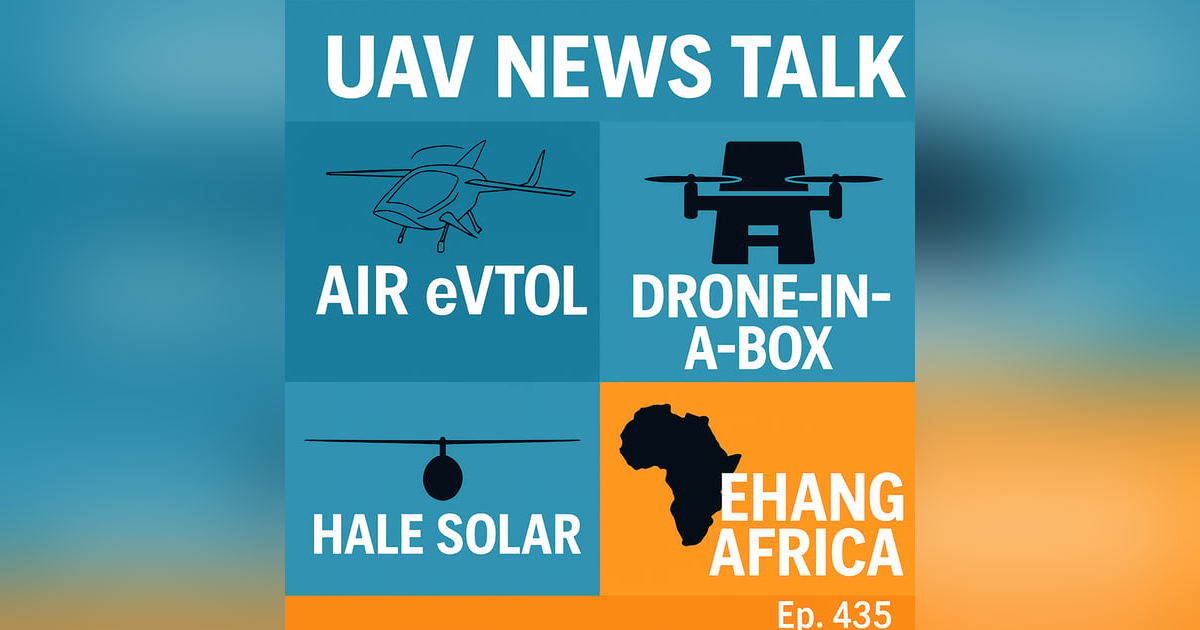FAA eVTOL Approvals, Drone-in-a-Box Tech, HALE Solar UAVs, and EHang’s African Debut

Max talks with David Vanderhoof in Episode 435 of UAV News Talk about an especially busy week in drone, eVTOL, and military UAV news. The episode covers new FAA certifications, autonomous launch systems, solar-powered endurance flights, Chinese technology in Africa, U.S. counter-drone readiness, and even a domestic security case involving explosives and drones. Together, these stories paint a vivid picture of how fast the unmanned aviation sector is evolving — and where the biggest opportunities and threats lie.
AIR eVTOL gains FAA Experimental Certificate
The first headline is the Israeli company AIR receiving an FAA experimental airworthiness certificate for its AIR One eVTOL. This isn’t the final approval needed for commercial operations, but it marks a critical milestone. The certificate allows AIR to expand its flight envelope testing in Florida — flying higher, faster, and with more maneuvering limits than before. Max explains that with this certificate, companies can begin validating systems under real-world conditions and build marketing buzz through legitimate flight footage.
However, limitations remain: only essential crew can be onboard. No journalists, investors, or passengers are allowed until type certification and a production certificate are granted. David points out discrepancies in reported pre-orders — one source cites 150, another 2,500 — and the hosts remind listeners that early order numbers in this industry often need to be taken with caution.
Max ties the discussion to the FAA’s MOSAIC rules for light-sport aircraft, which broaden certification pathways. These rules may make it easier for eVTOL manufacturers like AIR to secure final certification. For UAV enthusiasts and future pilots, this means the barriers to entry are slowly lowering, even if the process is still measured in years rather than months.
Germany’s “Drone-in-a-Box”
The second story introduces a “drone in a box” platform from Germany’s Skycar. This portable autonomous launch and recovery system can be mounted on trucks, ships, or rigid-hulled inflatable boats. Inside the box: a drone, charging system, and comms suite. Two models are supported, including the R70 SkyRanger, which can fly at up to 100 km/h.
Max and David highlight how this technology, initially aimed at military markets, could quickly spill into commercial applications. Imagine delivery companies like UPS or Amazon mounting these on vehicles, enabling drones to launch, deliver, and recharge without human intervention. First responders could also benefit, deploying drones at wildfire scenes, active shooter incidents, or rescue operations. Even lifeguards or cruise ships might one day use such systems for rapid deployment of flotation devices or surveillance.
The takeaway is that “drone in a box” technology represents a turnkey UAV ecosystem — plug it into any vehicle, and suddenly it’s drone-enabled.
HALE Solar UAV Achieves 73-Hour Flight
Next, the hosts discuss the U.S. Navy and SkyDweller Aero’s successful high-altitude long-endurance (HALE) UAV test at Patuxent River Naval Air Station. Powered by solar energy, the UAV stayed aloft for more than 73 continuous hours. Max compares this to Solar Impulse’s world-circumnavigation, noting that daytime solar climbs and nighttime battery descents make such endurance possible.
David emphasizes the military significance: persistent surveillance over a battlespace for three days straight. Unlike satellites, which pass overhead only periodically, HALE UAVs can loiter over a target area for extended periods, making them invaluable for ISR (intelligence, surveillance, reconnaissance).
Challenges remain: the huge wings required for solar panels limit where the UAV can operate, and structural fragility makes turbulence a risk. But the Navy’s test demonstrates that solar endurance UAVs could fill roles once reserved for P-3 Orions or P-8 Poseidons — at a fraction of the cost.
Hang’s First Passenger Flight in Africa
The show then turns to China’s EHang, which completed its first autonomous passenger eVTOL demonstration in Rwanda. Government officials, including Rwanda’s president, observed the flight. While it was largely symbolic, it underscores China’s push to expand its low-altitude economy influence beyond Asia and into Africa.
Max notes that although EHang claims over 73,000 safe flights, questions remain about how many involved passengers. Still, it’s clear EHang is ahead of U.S. companies in terms of international demos. David adds that Rwanda’s relatively uncongested airspace may make it easier to adopt pilotless eVTOLs than in places like New York or London.
Both hosts admit they’d eventually like to ride in one — but only after many others have tested it first.
Counter-Drone Warfare and APKWS
The next topic is sobering: a new report says the U.S. military is not prepared for large-scale low-cost drone threats like those seen in Ukraine and the Middle East. Expensive systems like Sidewinders aren’t cost-effective against $2,500 quadcopters.
Fortunately, innovations are underway. At Eglin AFB, the Air Force tested the APKWS (Advanced Precision Kill Weapon System) on F-15s. By converting unguided Hydra rockets into guided weapons, each fighter can carry dozens of low-cost munitions instead of only a handful of high-end missiles. Max calls this a smart adaptation for asymmetric warfare, where cheap drones can overwhelm even the most advanced aircraft.
FBI Sting Foils Domestic Drone Attack
The final major story covers a chilling domestic case. A 24-year-old man pled guilty after plotting to use a C-4-laden drone to attack power substations. The FBI, using undercover operatives, allowed the plan to progress to the point where the drone was powered up before stepping in. Thankfully, no attack occurred, but the case highlights how dual-use UAV technology can be weaponized.
David reflects on how easily hobby drones can be repurposed for harm, echoing lessons from Ukraine where small quadcopters wreak havoc. Max recalls seeing early RC drone battles and feeling uneasy about technology designed to destroy itself rather than innovate for good.
Closing Thoughts
The episode ends with lighter anecdotes: an RC plane accident at a California airshow and the benefits of AMA membership for insurance. Max shares how his wife encouraged him to take up RC flying — the hobby that led him into drones and, eventually, UAV News Talk itself.










